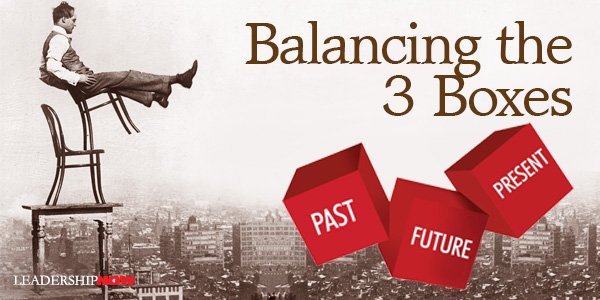 |
 |
05.10.16

Balancing the 3 Boxes
ULTIMATELY our future is not in linear—incremental—improvements. It is in nonlinear—nonconforming, breakthrough—change. But the future is built in the now and that’s the problem. What should we be doing now to ensure we have a future? Dartmouth professor Vijay Govindarajan writes, “As much as we might pay lip service to the fact that the future will differ dramatically from the past, we often behave as though it will be exactly the same.” There is a tension between and what we have to do now to continue on as an entity and what we need to be doing now to create our future along with the things that we are doing that get in our way of doing any of it. How do we create the future while managing the present? Vijay Govindarajan has incorporated good principles for managing change into a framework he calls The Three Box Solution. It is a method to simultaneously meet the performance demands of your current business—one that is still thriving—while dramatically reinventing it for the future. It’s about managing preservation, destruction, and creation. In each Box there is a function that needs to be performed to lead a sustainable business: Box 1: The Present Box – Manage the present core business at peak efficiency and profitability. Box 2: The Past Box – Selectively forget the traps of the past by identifying and divesting businesses and abandoning practices, ideas, and attitudes that have lost relevance in a changed environment and would otherwise interfere with your focus on inventing the future. Box 3: The Future Box – Generate nonlinear, breakthrough ideas and convert them, through experimentation, into new products and businesses. It’s not about predicting the future but it is about being prepared for circumstances you can not control. The Three-Box Solution requires an ability to think and act simultaneously in multiple time frames. Each requires different leadership and you must maintain balance across the 3 boxes. It’s a balance. Most businesses focus on Box 1 – preservation. And understandably so: the rewards are immediate, it is a known quantity and the risks are relatively low. Here’s the challenge: The greater your success in Box 1, the more difficulties you are likely to face in conceiving and executing breakthrough Box 3 strategies. This “success trap” typically arises not from willful intention but from the overwhelming power of success that the past has brought. The most pernicious effect of the success trap is that it encourages a business to suppose it already knows what it needs to know in order to succeed in the future. Boxes 2 and 3 are about creating the future. In Box 1 there is a value in sticking to what you have been good at, but in Box 3 you throw it out. The idea is to be building the future continuously instead of waiting until you are forced to do something. By then it is generally too late. Boxes 2 and 3 are easy to ignore because “when you neglect the future today, you don’t see the damage today.” Box 2 is especially difficult because it is hard to give up on the assumptions that got you where you are today. (Even if they are not working for you, to be frank.) Our resistance to selectively give up the past is arrogance. It reflects a desire to control our world. But it changes and we must strategically change with it. Box 2 issues limit our futures. They are obstacles to Box 3. “It is harder for an organization to admit to itself that it’s time to stop doing something than to know when it’s time to invent something new” in part, because we have so much invested in the past. It becomes an emotional issue. If you “ride the obedient horse of Box 1 all the way through Box 2 and into Box 3 without stopping to consider what needs to be forgotten, you end up stuck in your comfort zone.” Box 1 must be performing or Box 3 concerns are much more difficult to deal with. The 3-Box Solution is a daily operational balancing act. For leaders it means:

Posted by Michael McKinney at 10:29 PM
|
BUILD YOUR KNOWLEDGE
 

How to Do Your Start-Up Right STRAIGHT TALK FOR START-UPS 
Grow Your Leadership Skills NEW AND UPCOMING LEADERSHIP BOOKS 
Leadership Minute BITE-SIZE CONCEPTS YOU CAN CHEW ON 
Classic Leadership Books BOOKS TO READ BEFORE YOU LEAD |